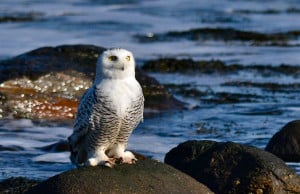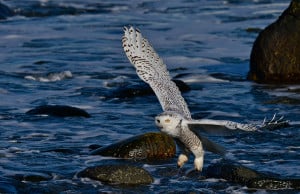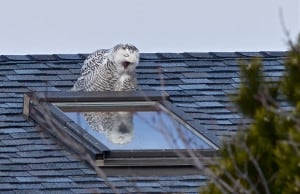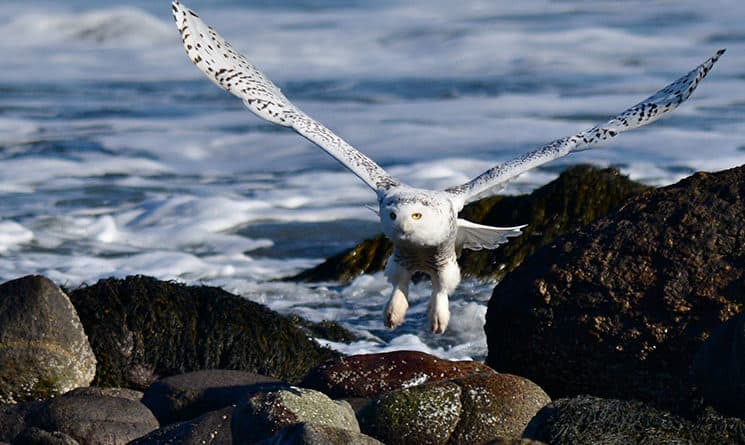Dozens of people gathered near Rye Harbor State Park on Saturday, Dec. 27, lining either side of the bend on Route 1A. They stared upward, some with binoculars, others with long-lensed cameras mounted on tripods. Passing drivers and motorcyclists slowed down and followed the crowd’s skyward gazes, while a police officer stopped to move along illegally parked vehicles.
The subject of these roadside paparazzi was a snowy owl perched atop a utility pole. The large white bird stood with its back to the sea, its strikingly yellow eyes scanning the salt marsh across the street. After 10 minutes or so it took flight, swooping low over the road and alighting on the crest of a nearby rooftop.
The owl seemed unperturbed by its human admirers. After all, this raptor is at the top of the food chain.
“They’re a top predator,” said Emily Calhoun, education and outreach coordinator at the York Center for Wildlife. “They know they’re up high; they know you guys down below are not a threat.”
Snowy owls are a prized sight for birders and wildlife enthusiasts. Unlike most owls, snowies are diurnal, meaning they’re active during the day rather than at night. And they tend to stay in the same area all winter long, so they’re easy to find.
Katherine Davis, a wildlife photographer from Rowley, Mass., spent the weekend snapping photos of the bird in Rye.
“They’re territorial, so once they stake out their territory, they just hang around,” Davis said as she watched the bird on Saturday.

Davis came to the same spot last winter to take pictures of a snowy owl. She thinks the latest visitor is the same bird as then, but she can’t say for certain. It’s also hard to tell the owl’s gender, as the males and females look nearly identical. “It’s just about impossible to tell unless you’re really up close,” she said.
What is known is that snowy owls have been seen more frequently than usual in the Seacoast over the past two winters — especially last year. The birds are native to the Arctic tundra and don’t normally make it this far south in large numbers. But last winter was an irruption year, which means there was a huge boost in the snowy population. In their native habitat, snowy owls feed mainly on lemmings. When lemmings are abundant, the owls thrive and have lots of offspring.
“What ends up happening is the young have to be displaced because there’s not enough habitat to accommodate all the young and all the adults,” Calhoun said.
Snowy owls seen in New England have traveled vast distances and will likely stay through the winter before returning home next spring to breed. “They come thousands of miles,” Davis said.
Irruptions typically happen on a four-year cycle, but last year’s surge was extraordinary. “It’s very, very unusual to have one of those extremely large irruptions,” Calhoun said.
The birds do not appear to be as prevalent this winter, but there have been several sightings along the New Hampshire coast. Sandy beaches provide an ideal alternative to tundra, and although there are no lemmings around here, there are plenty of other food sources. According to Calhoun, snowy owls are known to prey on mallards and sea ducks like eiders. “I’ve even heard of them going after larger raptors like peregrine falcons and other small owl species,” she said.
With a wingspan of up to 5 feet, snowy owls are among the biggest birds around. And while they look serene and beautiful, they are deadly predators. “Their talons can crush something like 300 pounds per square inch. They’re incredibly strong birds,” Calhoun said.
“Their talons can crush something like 300 pounds per square inch. They’re incredibly strong birds.” — Emily Calhoun, York Center for Wildlife

Prowling for owls
By Calhoun’s count, there are 11 owl species that frequent the Seacoast area (some experts count the burrowing owl as a 12th, but they’re extremely rare in New England). All but the snowy are nocturnal, which makes the others a bit harder to spot.
The Center for Wildlife rehabilitates injured animals and, when possible, returns them to the wild. Last winter, the center treated four snowy owls and was able to release two of them, Calhoun said.
Some animals recover but cannot be fully rehabilitated. They become permanent residents of the center and are often featured in educational programs. Right now, the center has seven individual “non-releasable” owls, representing four species: barred, great horned, long-eared, and eastern screech-owls.
Barred owl Byron and great horned owl Gaia, permanent residents of the York Center for Wildlife. Photos by Don Crasco
Visitors can meet some of these representatives during the center’s Winter Owl Prowl series. Educators from the center teach guests about the ecology, natural history and adaptations of native species and introduce some resident owls. Then they practice some owl calls and head into the woods with their ears and eyes open.
The center has been holding owl prowls for a few years now, and the events have become increasingly popular. This winter, they decided to hold the prowls more frequently, alternating between adult-only and all-ages programs.
“Our community has shown us that they’re interested in owl prowls, so now we’re hosting at least one a month,” Calhoun said. “It’s been hugely popular. Every owl prowl we’ve hosted so far has been very well attended.”
The next owl prowl is an adult-only event on Friday, Jan. 2, from 5:30 to 7 p.m. There’s another adult prowl on Feb. 6, followed by a family prowl on March 6.
Even if you can’t make it to the owl prowl, there’s a good chance you can glimpse at least one snowy owl in the area. Head to Rye Harbor State Park and scan the rooftops and telephone poles. Or just look for all the cameras.
The Winter Owl Prowl series takes place at the Center for Wildlife Pavilion, 385 Mountain Road, Cape Neddick, Maine. There is a $5 suggested donation; reservations are required. Contact Emily Calhoun at coordinator@yorkcenterforwildlife.org.


